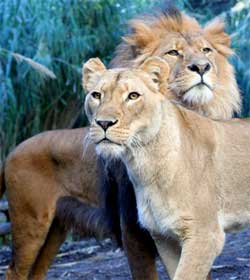Sexy lion at mane
 If given the choice, the female lion is more willing to lean on a sloppy man from Chicago than a guy with a neat, elegant outfit from Houston.
If given the choice, the female lion is more willing to lean on a sloppy man from Chicago than a guy with a neat, elegant outfit from Houston.
American scientists measured the size and thickness of lion manes at northern and southern zoos, stretching over 3,000 kilometers from Illinois to Texas. The average temperature in the zoos studied ranged from -6 to 10 degrees Celsius in January to 18-30 degrees Celsius in July.
They found that members of the lord of the lord living in colder climates had a better diaphragm roof - the key factor determining the attractiveness of female lions. The quality of the mane emitted signals for both sexes. A magnificent messy head told the other guys "go away" and be the "back here" message to the girls.
In the past, nutrition, social factors and genomes were considered important factors affecting the amount of mane, but recent findings demonstrate half the length and thickness of this sex symbol. is determined by temperature.
The thick mane will keep the heat in a hot dry climate, as if someone wore a fur cap, making the animal become extremely frustrated.
While all lions have full manes around the front, apricot, shoulder and throat, the ones living in the southern zoos lack hair on other parts like the abdomen, back, ribs. and those compared to their congeners in the north.
The lions are in the north, which represents a child in Illinois and one from St. Louis, both have extremely sexy mane. The hair grows down to half the back, covering both the front legs and even the abdomen. In contrast, two guys from the south, one from Houston and one from Tyler (Texas) all have a manly looking mane. But their hair is thinner than the ones in the north and less hair on the back as well as the belly.
But the sexy mane also has its price. It is a remote alarm signal for the prey, which makes it difficult for lions to move through the bushes, which may be the lodge's hideout.
In addition, raising the mane also makes the animal quite expensive for food and maintenance, which is why captive lions often have a shorter mane.
T. An
- Strange 18-year-old female lion grows mane like a male
- The strange lion had a thick mane covering his stomach
- Discover interesting luscious lion mane mushroom
- The world's largest species of jellyfish in the White Sea
- Why not take the lion's mane man?
- The first tiger lion gave birth in Russia
- The lion smiled mysteriously in front of the camera lens
- Women showing off their self-image, sexy
- The BBC was deeply touched by the moment of farewell to the female lion's poisoned child
- Zoologist: The film 'The Lion King' describes completely the wrong male lion role in practice
- 10 longest marine animals
- For the first time, a complete reconstruction of the prehistoric lion lion skeleton was completed
 Animal 'suffering' after hibernation
Animal 'suffering' after hibernation Why do goats climb well?
Why do goats climb well? Scientists were surprised to see chimpanzees eating turtles
Scientists were surprised to see chimpanzees eating turtles Giant catfish died deadly due to drought in Thailand
Giant catfish died deadly due to drought in Thailand